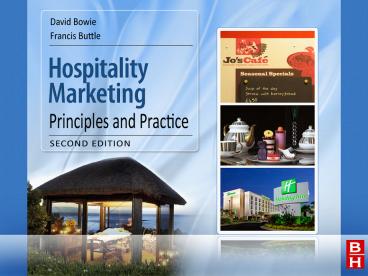Introduction to hospitality marketing PowerPoint PPT Presentation
Title: Introduction to hospitality marketing
1
(No Transcript)
2
Introduction to hospitality marketing
3
Lecture plan
- What is Marketing?
- Definitions
- Hierarchy of customer value
- Marketing Concept
- Management Orientations
- Environmental Influences
- Macro
- Micro
- Special Characteristics of Services Marketing
- Hospitality Marketing Mix
4
Definitions of marketing
- Many different definitions of marketing
- business philosophy to create and retain
satisfied customers - exchange process short term transactional
marketing - relationship marketing - development of mutually
beneficial long-term relationships between
suppliers and customers - creating memorable experiences
5
Figure 1.1 The hierarchy of customer value
6
The marketing concept
- Marketing is
- a business philosophy with the customer at the
center of a hospitality organizations purpose - an exchange activity between hospitality
organizations and their customers - a management process that focuses on planning for
the future success of the organization - a set of marketing tools, which marketers use to
understand customers needs and wants and to
develop products, and services to satisfy or
delight customers - The central purpose of marketing is to manage
demand
7
Management orientations
- Product or service orientation
- Operations or production orientation
- Selling orientation
- Marketing orientation
- Societal marketing orientation
8
Figure 1.2 Marketing orientations
9
Figure 1.3 Macro- and micro-environmental
influences on hospitality organizations
10
Macro-environmental influences
- The macro-environment
- Political
- Economic
- Socio-cultural
- Technological
- Environmental
- Interaction of PESTE factors
11
Impact of macro-environment
- Hospitality companies have limited control over
PESTE influences but major changes in even one
PESTE factor can significantly impact on the
business, either for better or worse - PESTE factors are constantly changing
12
Business cycle
- Growth Occupancy and room rates increase in
response to growing demand - Peak Occupancy and room rates remain strong,
funds still available for investment growth
tends to slow - Decline Occupancy begins to decrease
- Trough There is a large imbalance of supply and
demand during a recession hospitality businesses
fail - Resurgence There is a gradual resurgence, and
the cycle starts all over again
13
Figure 1.4 Typical hotel industry cycle
14
Micro-environment
- internal company factors
- customers
- employees
- Suppliers
- Intermediaries
- external factors
- direct competitors
- various publics
15
Micro-environment
- Hospitality companies have more influence
over the micro-environment than over the
macro-environment
16
Special characteristics of services marketing
- seasonality
- intangibility
- Perishability
- Inseparability
- Variability
- Interdependence
- supply
- exceeding demand
- high fixed costs
17
Hospitality marketing mix
- The term marketing mix is used to describe the
tools that the marketer uses to influence demand - The marketing mix is a core concept in marketing
- The hospitality marketing mix adopted in this
text is - based on the eight marketing activities
18
Figure 1.5 The hospitality marketing mix
19
Jobs in hospitality marketing
- People who work in marketing work in
- online and offline advertising, sales promotion
and publicity - sales, sales promotion, print and publicity,
direct mail, advertising, - public relations and customer relations
- marketing research
- online sales and marketing roles such as guest
user interface (GUI) management, web product
development, website sales, search engine
optimization - database management, daily web operations and
content management
20
References and further reading
- Albrecht, K. (1992). The only thing that matters.
Harper Business Books. - American Marketing Association. (October 2007).
http//www.marketingpower. - com/aboutama/pages/definitionofmarketing.aspx.
- Brown, S. (2001). Marketing The retro
revolution. Sage. - Carlzon, J. (1987). Moments of truth. Ballinger
Publishing. - Chartered Institute of Marketing (2007). Shape
the Agenda Tomorrows word, - re-evaluating the role of marketing, October
2007. - Grönroos, C. (1994). From marketing mix to
relationship marketing towards a - paradigm shift in marketing. Management
Decision, 32, 420. - http//www.fairmount.com.
- Kotler, P. (1999). Kotler on marketing. Simon and
Schuster. - Kotler, P. (2003). Marketing management. Prentice
Hall. - Kotler, P., Armstrong, G. (2010). Principles of
marketing. Pearson Education. - Kotler, P., Bowen, J., Makens, J. (2009).
Marketing for hospitality and - Tourism (5th ed.). Prentice Hall.
- Levitt, T. (1960). Marketing myopia. Harvard
Business Review, 38, 4556. - Pine, J., Gilmore, J. H. (1999). The experience
economy. Harvard Business - School Press.

